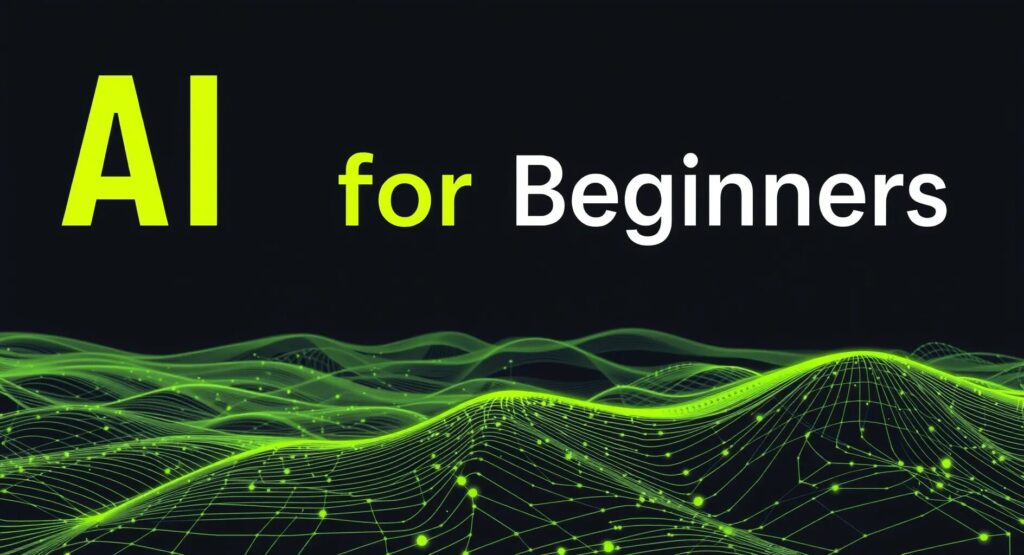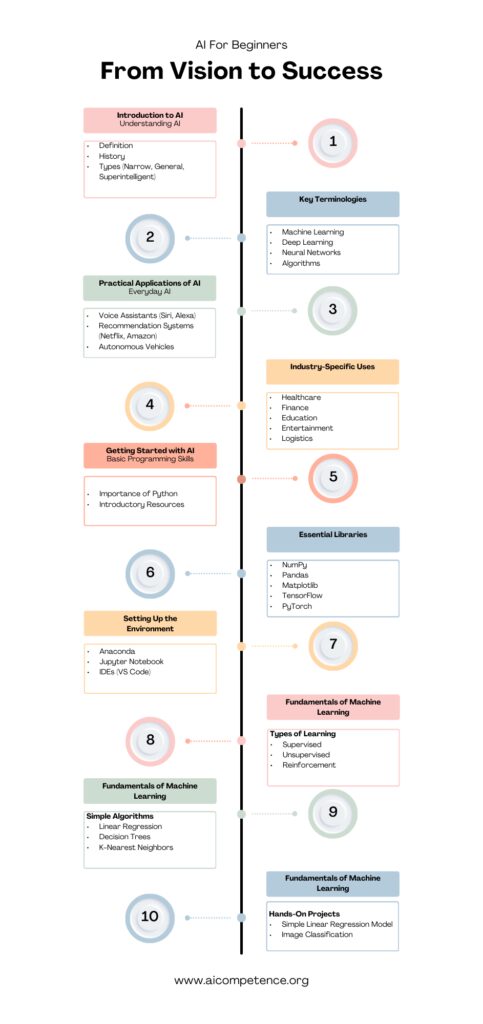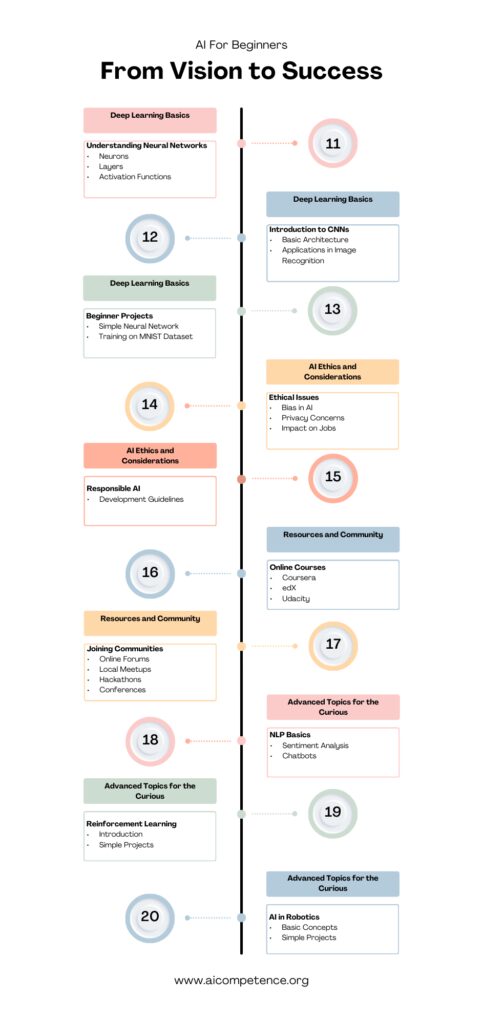
Welcome, AI Newbies! Unlock the Power of AI! As we stand on the brink of a technological revolution, AI promises to transform every aspect of our lives, from how we work and communicate to how we solve some of the world’s most pressing challenges. This guide is designed to be your gateway into this fascinating domain, offering a clear path from fundamental concepts to practical applications and future possibilities.
AI is not just a field of study; it’s a dynamic and rapidly evolving landscape that holds the potential to reshape industries, enhance human capabilities, and address global issues. Whether you’re a curious beginner eager to understand the basics or an aspiring technologist looking to build a career in AI, this guide will provide you with the essential knowledge and tools you need to start your journey.
Embark on this adventure with us, and discover how AI can unlock new horizons and create a future filled with innovation and possibility. From understanding core concepts and learning programming skills to exploring ethical considerations and joining vibrant AI communities, this guide is your comprehensive resource to navigate the exciting terrain of Artificial Intelligence. Let’s dive in and explore the limitless opportunities that AI has to offer!
From Vision to Success:


Introduction to AI & Understanding AI
Definition
Artificial Intelligence (AI) is the branch of computer science dedicated to creating systems capable of performing tasks that typically require human intelligence. These tasks include learning, reasoning, problem-solving, understanding language, and perception. Essentially, AI is about building machines that can think and learn like humans.
History
The roots of AI can be traced back to ancient myths and legends, where machines and automatons were depicted with human-like qualities. However, the modern concept of AI began to take shape in the mid-20th century. In 1956, the term “Artificial Intelligence” was officially coined by John McCarthy at the Dartmouth Conference, marking the beginning of AI as a formal field of study.
Early AI research focused on symbolic reasoning and problem-solving, leading to the development of the first AI programs like the Logic Theorist and the General Problem Solver. These early efforts laid the groundwork for the AI systems we see today.
Types of AI: Narrow, General, and Superintelligent
Narrow AI (Weak AI):
Narrow AI refers to systems that are designed to perform a specific task. This is the most common form of AI in use today. Examples include virtual assistants like Siri and Alexa, recommendation algorithms on platforms like Netflix, and image recognition software.
General AI (Strong AI):
General AI represents a level of artificial intelligence that can perform any intellectual task that a human can do. Unlike Narrow AI, which is limited to specific tasks, General AI would have the ability to understand, learn, and apply knowledge in a wide variety of contexts. However, General AI remains a theoretical concept, with no existing systems yet achieving this level of capability.
Superintelligent AI:
Superintelligent AI is a hypothetical concept that refers to AI systems that surpass human intelligence in all respects. Such systems would be capable of performing tasks and solving problems that are beyond the capabilities of any human being. The idea of superintelligent AI raises significant ethical and philosophical questions, as it could have profound implications for the future of humanity.
This introductory overview sets the stage for a deeper exploration into the world of AI, providing a foundational understanding of what AI is, where it comes from, and the different forms it can take. In the following sections, we will delve into the core concepts that drive AI, explore current applications, and discuss the future potential of this transformative technology.
Practical Applications of AI in Everyday Life
Artificial Intelligence is no longer just a concept found in science fiction; it has become an integral part of our daily lives. Here are some practical applications of AI that many of us interact with regularly:
Voice Assistants (Siri, Alexa)
Voice assistants like Siri and Alexa are prime examples of how AI has seamlessly integrated into our everyday routines. These AI-powered tools use Natural Language Processing (NLP) to understand and respond to human speech. Whether you’re asking Siri to set a reminder, play your favorite song, or find the quickest route home, AI is at work behind the scenes, processing your voice commands and delivering accurate responses.
These voice assistants are continually learning from interactions, improving their ability to understand accents, languages, and even the context of what you’re saying. This makes them more effective at helping users manage their daily tasks, control smart home devices, and stay organized.
Recommendation Systems (Netflix, Amazon)
Have you ever wondered how Netflix always seems to know what show you’ll enjoy next, or how Amazon suggests products you didn’t even know you wanted? These capabilities are driven by AI-powered recommendation systems.
Recommendation systems use machine learning algorithms to analyze your past behavior—such as movies you’ve watched or products you’ve purchased—to predict what you might like in the future. By processing vast amounts of data, these systems can offer personalized suggestions that enhance your experience, making it easier and faster to find content or products that match your preferences.
This type of AI application not only improves user satisfaction but also drives engagement and sales for companies, making it a win-win situation for both consumers and businesses.
Getting Started with AI: Basic Programming Skills
To dive into the world of AI, having a solid foundation in programming is crucial. One of the most widely used languages for AI development is Python.
Importance of Python
Python has become the go-to language for AI and machine learning due to its simplicity and versatility. Its clear syntax makes it accessible to beginners, while its extensive libraries—like TensorFlow, Keras, and scikit-learn—provide powerful tools for developing AI applications. Whether you’re building a basic model or working on complex neural networks, Python’s rich ecosystem allows you to do so efficiently.
Additionally, Python’s large and active community means that resources, tutorials, and support are readily available, making it easier for newcomers to start learning AI development.
Introduction to Python
Starting with Python is straightforward. As a beginner, you’ll want to familiarize yourself with the basics of the language, such as variables, data types, loops, and functions. From there, you can move on to more advanced topics like object-oriented programming and working with data structures.
Once you’re comfortable with the basics, you can begin exploring Python’s AI-specific libraries. For example, NumPy and Pandas are essential for data manipulation, while Matplotlib and Seaborn are great for data visualization. As you progress, you can start building simple machine learning models, experimenting with different algorithms, and eventually working on full-scale AI projects.
By mastering Python, you’ll be well-equipped to begin your journey into the exciting world of Artificial Intelligence.
Setting Up the Environment
Before you can start coding and experimenting with AI, it’s essential to set up a development environment that allows you to work efficiently. Here are some tools that are widely used in the AI community:
Anaconda
Anaconda is a powerful open-source distribution that simplifies package management and deployment. It comes pre-installed with numerous essential libraries for data science and AI, such as NumPy, Pandas, Matplotlib, and more. Anaconda also includes Conda, a package manager that makes it easy to install and manage dependencies, ensuring that your AI projects run smoothly.
Using Anaconda, you can create isolated environments for different projects, which helps avoid conflicts between libraries. This is particularly useful when working on multiple AI projects that may require different versions of the same library.
Jupyter Notebook
Jupyter Notebook is an interactive web-based environment that allows you to write and execute Python code in a document-like format. It is highly popular in the AI community because it supports code, visualizations, and markdown text in the same document. This makes it an excellent tool for experimenting with code, documenting your workflow, and sharing your findings with others.
With Jupyter Notebook, you can run code in small chunks, see the output immediately, and make adjustments on the fly. This interactive nature makes it ideal for learning AI concepts, performing data analysis, and developing machine learning models.
IDEs (VS Code)
While Jupyter Notebook is great for experimentation, you might prefer an Integrated Development Environment (IDE) for larger projects. Visual Studio Code (VS Code) is a lightweight, yet powerful IDE that has become a favorite among developers. It supports a wide range of programming languages, including Python, and offers many extensions that enhance your productivity.
VS Code provides features like syntax highlighting, code completion, debugging, and version control, making it easier to manage and scale AI projects. Its integration with Git and other version control systems is particularly useful for collaborative projects.
By setting up your environment with tools like Anaconda, Jupyter Notebook, and VS Code, you’ll be well-prepared to start developing AI applications.
Key Terminologies
As you dive deeper into the world of AI, you’ll encounter several key terms that are fundamental to understanding and working with AI technologies. Here are some of the most important ones:
Machine Learning
Machine Learning (ML) is a subset of AI that focuses on developing algorithms that allow computers to learn from and make decisions based on data. Instead of being explicitly programmed to perform a task, machine learning models are trained on data, enabling them to identify patterns, make predictions, and improve their performance over time.
For example, a machine learning algorithm might be trained on a dataset of images to recognize cats. Over time, as it processes more images, the algorithm becomes better at distinguishing between cats and other objects, even if it has never seen those specific images before.
Deep Learning
Deep Learning is a specialized subset of machine learning that uses neural networks with many layers (hence “deep”) to analyze large amounts of data. Deep learning models are particularly powerful for tasks like image recognition, natural language processing, and speech recognition.
Neural networks are designed to mimic the structure and function of the human brain, with layers of interconnected nodes that process and learn from data. Deep learning has led to significant breakthroughs in AI, enabling systems to achieve high levels of accuracy in complex tasks, such as autonomous driving and medical diagnosis.
Algorithms
In the context of AI, an algorithm is a set of rules or instructions that a machine follows to solve a problem or complete a task. Machine learning algorithms are designed to learn from data and make predictions or decisions without human intervention. Some common types of algorithms used in AI include:
- Linear Regression: Used for predicting a continuous output based on input variables.
- Decision Trees: A model that splits data into branches to make decisions or classifications.
- Neural Networks: A complex algorithm that simulates the human brain to recognize patterns and learn from data.
Understanding these key terms—machine learning, deep learning, and algorithms—is essential as they form the backbone of many AI technologies and applications. With these concepts in hand, you’ll be better equipped to navigate the AI landscape and begin developing your own AI-powered solutions.
Industry-Specific Uses
Artificial Intelligence is making a profound impact across various industries, revolutionizing how businesses operate and how services are delivered. Here’s how AI is transforming some key sectors:
Healthcare
In healthcare, AI is enhancing the way medical professionals diagnose and treat diseases. AI-powered systems can analyze medical images to detect conditions like tumors or fractures with high accuracy. Predictive analytics help in forecasting patient outcomes and personalizing treatment plans based on individual genetic profiles. Additionally, AI-driven tools are assisting in drug discovery, speeding up the process of bringing new treatments to market.
Virtual health assistants and chatbots also use AI to provide 24/7 support, answering patients’ questions and guiding them through treatment plans, which reduces the burden on healthcare professionals.
Finance
In the finance industry, AI is playing a crucial role in fraud detection, risk management, and investment strategies. Machine learning algorithms can analyze vast amounts of transaction data in real-time, identifying patterns that indicate fraudulent activity. This helps financial institutions prevent fraud before it causes significant damage.
AI is also used in algorithmic trading, where systems execute trades at optimal times based on market data analysis, often outperforming human traders. Furthermore, AI-driven robo-advisors offer personalized investment advice, making financial planning more accessible to the average person.
Education
Education is another field where AI is making significant strides. Adaptive learning platforms use AI to tailor educational content to individual student needs, ensuring that each learner gets the support they need to succeed. AI can analyze a student’s performance and suggest personalized resources, helping to close knowledge gaps.
AI-powered tutoring systems provide on-demand assistance, while automated grading tools reduce the workload for educators, allowing them to focus more on teaching and less on administrative tasks. These advancements make education more efficient and accessible, particularly in remote or underserved areas.
Entertainment
In the entertainment industry, AI is transforming how content is created and consumed. Recommendation algorithms used by streaming platforms like Netflix and Spotify analyze user preferences to suggest movies, shows, or music that match their tastes, enhancing the overall user experience.
AI is also being used to create content, with algorithms generating music, scripts, and even visual art. Deep learning models are used in video game development to create more realistic environments and intelligent non-player characters (NPCs) that can adapt to the player’s actions, providing a more immersive gaming experience.
Logistics
In logistics, AI optimizes supply chains and enhances operational efficiency. Predictive analytics help companies forecast demand, manage inventory, and optimize routes for delivery vehicles. AI-powered robots are used in warehouses to sort, pack, and ship products more efficiently than human workers.
Autonomous vehicles and drones are being developed to handle deliveries, reducing the time and cost associated with shipping goods. This technology is particularly beneficial in handling the complexities of last-mile delivery, ensuring that products reach customers faster and at a lower cost.
Continue reading >>